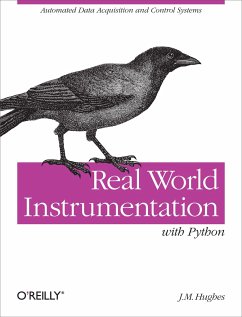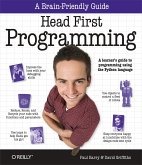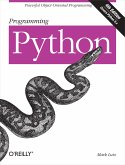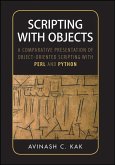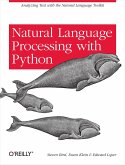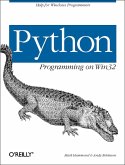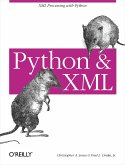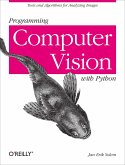- Broschiertes Buch
- Merkliste
- Auf die Merkliste
- Bewerten Bewerten
- Teilen
- Produkt teilen
- Produkterinnerung
- Produkterinnerung
Learn how to develop your own applications to monitor or control instrumentation hardware. Whether you need to acquire data from a device or automate its functions, this practical book shows you how to use Python's rapid development capabilities to build interfaces that include everything from software to wiring. You get step-by-step instructions, clear examples, and hands-on tips for interfacing a PC to a variety of devices.
Andere Kunden interessierten sich auch für
![Head First Programming Head First Programming]() David GriffithsHead First Programming44,99 €
David GriffithsHead First Programming44,99 €![Programming Python Programming Python]() Mark LutzProgramming Python68,99 €
Mark LutzProgramming Python68,99 €![Scripting with Objects Scripting with Objects]() Avinash C. KakScripting with Objects122,99 €
Avinash C. KakScripting with Objects122,99 €![Natural Language Processing with Python Natural Language Processing with Python]() Steven BirdNatural Language Processing with Python56,99 €
Steven BirdNatural Language Processing with Python56,99 €![Python Programming on WIN32 Python Programming on WIN32]() Mark HammondPython Programming on WIN3256,99 €
Mark HammondPython Programming on WIN3256,99 €![Python & XML Python & XML]() Christopher A. JonesPython & XML30,99 €
Christopher A. JonesPython & XML30,99 €![Programming Computer Vision with Python Programming Computer Vision with Python]() Jan Erik SolemProgramming Computer Vision with Python55,99 €
Jan Erik SolemProgramming Computer Vision with Python55,99 €-
-
-
Learn how to develop your own applications to monitor or control instrumentation hardware. Whether you need to acquire data from a device or automate its functions, this practical book shows you how to use Python's rapid development capabilities to build interfaces that include everything from software to wiring. You get step-by-step instructions, clear examples, and hands-on tips for interfacing a PC to a variety of devices.
Produktdetails
- Produktdetails
- Verlag: O'Reilly Media
- Seitenzahl: 619
- Erscheinungstermin: 28. Dezember 2010
- Englisch
- Abmessung: 231mm x 180mm x 38mm
- Gewicht: 818g
- ISBN-13: 9780596809560
- ISBN-10: 0596809565
- Artikelnr.: 30630500
- Herstellerkennzeichnung
- Libri GmbH
- Europaallee 1
- 36244 Bad Hersfeld
- gpsr@libri.de
- Verlag: O'Reilly Media
- Seitenzahl: 619
- Erscheinungstermin: 28. Dezember 2010
- Englisch
- Abmessung: 231mm x 180mm x 38mm
- Gewicht: 818g
- ISBN-13: 9780596809560
- ISBN-10: 0596809565
- Artikelnr.: 30630500
- Herstellerkennzeichnung
- Libri GmbH
- Europaallee 1
- 36244 Bad Hersfeld
- gpsr@libri.de
John M. Hughes is an embedded systems engineer with over 30 years of experience in electronics, embedded systems and software, aerospace systems, and scientific applications programming. He was responsible for the surface imaging software on the Phoenix Mars Lander, and has worked on digital engine control systems for commercial and military aircraft, automated test systems, radio telescope data acquisition, and realtime adaptive optics controls for astronomy. Hughes has been using Python for many years in a variety of applications, including the software for a multiwavelength laser interferometer system for verifying the alignment of telescope mirror segments on the James Webb Space Telescope. He is currently using Python for imaging systems simulation and analysis at the University of Arizona.
Preface
Who Is This Book For?
The Programming Languages
Why Python?
The Systems
Methodology
How This Book Is Organized
Conventions Used in This Book
Using Code Examples
Safari® Books Online
How to Contact Us
Acknowledgments
Chapter 1: Introduction to Instrumentation
1.1 Data Acquisition
1.2 Control Output
1.3 Applications Overview
1.4 Summary
Chapter 2: Essential Electronics
2.1 Electrical Charge
2.2 Electric Current
2.3 Basic Circuit Theory
2.4 Circuit Schematics
2.5 DC Circuit Characteristics
2.6 AC Circuits
2.7 Interfaces
2.8 Summary
2.9 Suggested Reading
Chapter 3: The Python Programming Language
3.1 Installing Python
3.2 The Python Programming Language
3.3 Python Development Tools
3.4 Summary
3.5 Suggested Reading
Chapter 4: The C Programming Language
4.1 Installing C
4.2 Developing Software in C
4.3 C Development Tools
4.4 Summary
4.5 Suggested Reading
Chapter 5: Python Extensions
5.1 Creating Python Extensions in C
5.2 Python's C Extension API
5.3 Using the Python C Extension API
5.4 Python's ctypes Foreign Function Library
5.5 Summary
5.6 Suggested Reading
Chapter 6: Hardware: Tools and Supplies
6.1 The Essentials
6.2 Advanced Tools
6.3 Supplies
6.4 New Versus Used
6.5 Summary
6.6 Suggested Reading
Chapter 7: Physical Interfaces
7.1 Connectors
7.2 Serial Interfaces
7.3 GPIB/IEEE-488
7.4 PC Bus Interface Hardware
7.5 Old Doesn't Mean Bad
7.6 Summary
7.7 Suggested Reading
Chapter 8: Getting Started
8.1 Defining the Project
8.2 Requirements
8.3 Designing the Software
8.4 Functional Testing
8.5 Implementation
8.6 User Documentation
8.7 Summary
8.8 Suggested Reading
Chapter 9: Control System Concepts
9.1 Basic Control Systems Theory
9.2 Control System Types
9.3 Implementing Control Systems in Python
9.4 Summary
9.5 Suggested Reading
Chapter 10: Building and Using Simulators
10.1 What Is Simulation?
10.2 Using Python to Create a Simulator
10.3 Serial Terminal Emulators
10.4 Displaying Simulation Data
10.5 Creating Your Own Simulators
10.6 Summary
10.7 Suggested Reading
Chapter 11: Instrumentation Data I/O
11.1 Data I/O Interface Software
11.2 Data I/O: Acquiring and Writing Data
11.3 Summary
11.4 Suggested Reading
Chapter 12: Reading and Writing Data Files
12.1 ASCII Data Files
12.2 Binary Data Files
12.3 Summary
12.4 Suggested Reading
Chapter 13: User Interfaces
13.1 Text-Based Interfaces
13.2 Graphical User Interfaces
13.3 Summary
13.4 Suggested Reading
Chapter 14: Real World Examples
14.1 Serial Interfaces
14.2 USB Example: The LabJack U3
14.3 Summary
14.4 Suggested Reading
Free and Open Source Software Resources
Instrument Sources
Manufacturers
Used Test Equipment Sources
Manuals
Colophon
Who Is This Book For?
The Programming Languages
Why Python?
The Systems
Methodology
How This Book Is Organized
Conventions Used in This Book
Using Code Examples
Safari® Books Online
How to Contact Us
Acknowledgments
Chapter 1: Introduction to Instrumentation
1.1 Data Acquisition
1.2 Control Output
1.3 Applications Overview
1.4 Summary
Chapter 2: Essential Electronics
2.1 Electrical Charge
2.2 Electric Current
2.3 Basic Circuit Theory
2.4 Circuit Schematics
2.5 DC Circuit Characteristics
2.6 AC Circuits
2.7 Interfaces
2.8 Summary
2.9 Suggested Reading
Chapter 3: The Python Programming Language
3.1 Installing Python
3.2 The Python Programming Language
3.3 Python Development Tools
3.4 Summary
3.5 Suggested Reading
Chapter 4: The C Programming Language
4.1 Installing C
4.2 Developing Software in C
4.3 C Development Tools
4.4 Summary
4.5 Suggested Reading
Chapter 5: Python Extensions
5.1 Creating Python Extensions in C
5.2 Python's C Extension API
5.3 Using the Python C Extension API
5.4 Python's ctypes Foreign Function Library
5.5 Summary
5.6 Suggested Reading
Chapter 6: Hardware: Tools and Supplies
6.1 The Essentials
6.2 Advanced Tools
6.3 Supplies
6.4 New Versus Used
6.5 Summary
6.6 Suggested Reading
Chapter 7: Physical Interfaces
7.1 Connectors
7.2 Serial Interfaces
7.3 GPIB/IEEE-488
7.4 PC Bus Interface Hardware
7.5 Old Doesn't Mean Bad
7.6 Summary
7.7 Suggested Reading
Chapter 8: Getting Started
8.1 Defining the Project
8.2 Requirements
8.3 Designing the Software
8.4 Functional Testing
8.5 Implementation
8.6 User Documentation
8.7 Summary
8.8 Suggested Reading
Chapter 9: Control System Concepts
9.1 Basic Control Systems Theory
9.2 Control System Types
9.3 Implementing Control Systems in Python
9.4 Summary
9.5 Suggested Reading
Chapter 10: Building and Using Simulators
10.1 What Is Simulation?
10.2 Using Python to Create a Simulator
10.3 Serial Terminal Emulators
10.4 Displaying Simulation Data
10.5 Creating Your Own Simulators
10.6 Summary
10.7 Suggested Reading
Chapter 11: Instrumentation Data I/O
11.1 Data I/O Interface Software
11.2 Data I/O: Acquiring and Writing Data
11.3 Summary
11.4 Suggested Reading
Chapter 12: Reading and Writing Data Files
12.1 ASCII Data Files
12.2 Binary Data Files
12.3 Summary
12.4 Suggested Reading
Chapter 13: User Interfaces
13.1 Text-Based Interfaces
13.2 Graphical User Interfaces
13.3 Summary
13.4 Suggested Reading
Chapter 14: Real World Examples
14.1 Serial Interfaces
14.2 USB Example: The LabJack U3
14.3 Summary
14.4 Suggested Reading
Free and Open Source Software Resources
Instrument Sources
Manufacturers
Used Test Equipment Sources
Manuals
Colophon
Preface
Who Is This Book For?
The Programming Languages
Why Python?
The Systems
Methodology
How This Book Is Organized
Conventions Used in This Book
Using Code Examples
Safari® Books Online
How to Contact Us
Acknowledgments
Chapter 1: Introduction to Instrumentation
1.1 Data Acquisition
1.2 Control Output
1.3 Applications Overview
1.4 Summary
Chapter 2: Essential Electronics
2.1 Electrical Charge
2.2 Electric Current
2.3 Basic Circuit Theory
2.4 Circuit Schematics
2.5 DC Circuit Characteristics
2.6 AC Circuits
2.7 Interfaces
2.8 Summary
2.9 Suggested Reading
Chapter 3: The Python Programming Language
3.1 Installing Python
3.2 The Python Programming Language
3.3 Python Development Tools
3.4 Summary
3.5 Suggested Reading
Chapter 4: The C Programming Language
4.1 Installing C
4.2 Developing Software in C
4.3 C Development Tools
4.4 Summary
4.5 Suggested Reading
Chapter 5: Python Extensions
5.1 Creating Python Extensions in C
5.2 Python's C Extension API
5.3 Using the Python C Extension API
5.4 Python's ctypes Foreign Function Library
5.5 Summary
5.6 Suggested Reading
Chapter 6: Hardware: Tools and Supplies
6.1 The Essentials
6.2 Advanced Tools
6.3 Supplies
6.4 New Versus Used
6.5 Summary
6.6 Suggested Reading
Chapter 7: Physical Interfaces
7.1 Connectors
7.2 Serial Interfaces
7.3 GPIB/IEEE-488
7.4 PC Bus Interface Hardware
7.5 Old Doesn't Mean Bad
7.6 Summary
7.7 Suggested Reading
Chapter 8: Getting Started
8.1 Defining the Project
8.2 Requirements
8.3 Designing the Software
8.4 Functional Testing
8.5 Implementation
8.6 User Documentation
8.7 Summary
8.8 Suggested Reading
Chapter 9: Control System Concepts
9.1 Basic Control Systems Theory
9.2 Control System Types
9.3 Implementing Control Systems in Python
9.4 Summary
9.5 Suggested Reading
Chapter 10: Building and Using Simulators
10.1 What Is Simulation?
10.2 Using Python to Create a Simulator
10.3 Serial Terminal Emulators
10.4 Displaying Simulation Data
10.5 Creating Your Own Simulators
10.6 Summary
10.7 Suggested Reading
Chapter 11: Instrumentation Data I/O
11.1 Data I/O Interface Software
11.2 Data I/O: Acquiring and Writing Data
11.3 Summary
11.4 Suggested Reading
Chapter 12: Reading and Writing Data Files
12.1 ASCII Data Files
12.2 Binary Data Files
12.3 Summary
12.4 Suggested Reading
Chapter 13: User Interfaces
13.1 Text-Based Interfaces
13.2 Graphical User Interfaces
13.3 Summary
13.4 Suggested Reading
Chapter 14: Real World Examples
14.1 Serial Interfaces
14.2 USB Example: The LabJack U3
14.3 Summary
14.4 Suggested Reading
Free and Open Source Software Resources
Instrument Sources
Manufacturers
Used Test Equipment Sources
Manuals
Colophon
Who Is This Book For?
The Programming Languages
Why Python?
The Systems
Methodology
How This Book Is Organized
Conventions Used in This Book
Using Code Examples
Safari® Books Online
How to Contact Us
Acknowledgments
Chapter 1: Introduction to Instrumentation
1.1 Data Acquisition
1.2 Control Output
1.3 Applications Overview
1.4 Summary
Chapter 2: Essential Electronics
2.1 Electrical Charge
2.2 Electric Current
2.3 Basic Circuit Theory
2.4 Circuit Schematics
2.5 DC Circuit Characteristics
2.6 AC Circuits
2.7 Interfaces
2.8 Summary
2.9 Suggested Reading
Chapter 3: The Python Programming Language
3.1 Installing Python
3.2 The Python Programming Language
3.3 Python Development Tools
3.4 Summary
3.5 Suggested Reading
Chapter 4: The C Programming Language
4.1 Installing C
4.2 Developing Software in C
4.3 C Development Tools
4.4 Summary
4.5 Suggested Reading
Chapter 5: Python Extensions
5.1 Creating Python Extensions in C
5.2 Python's C Extension API
5.3 Using the Python C Extension API
5.4 Python's ctypes Foreign Function Library
5.5 Summary
5.6 Suggested Reading
Chapter 6: Hardware: Tools and Supplies
6.1 The Essentials
6.2 Advanced Tools
6.3 Supplies
6.4 New Versus Used
6.5 Summary
6.6 Suggested Reading
Chapter 7: Physical Interfaces
7.1 Connectors
7.2 Serial Interfaces
7.3 GPIB/IEEE-488
7.4 PC Bus Interface Hardware
7.5 Old Doesn't Mean Bad
7.6 Summary
7.7 Suggested Reading
Chapter 8: Getting Started
8.1 Defining the Project
8.2 Requirements
8.3 Designing the Software
8.4 Functional Testing
8.5 Implementation
8.6 User Documentation
8.7 Summary
8.8 Suggested Reading
Chapter 9: Control System Concepts
9.1 Basic Control Systems Theory
9.2 Control System Types
9.3 Implementing Control Systems in Python
9.4 Summary
9.5 Suggested Reading
Chapter 10: Building and Using Simulators
10.1 What Is Simulation?
10.2 Using Python to Create a Simulator
10.3 Serial Terminal Emulators
10.4 Displaying Simulation Data
10.5 Creating Your Own Simulators
10.6 Summary
10.7 Suggested Reading
Chapter 11: Instrumentation Data I/O
11.1 Data I/O Interface Software
11.2 Data I/O: Acquiring and Writing Data
11.3 Summary
11.4 Suggested Reading
Chapter 12: Reading and Writing Data Files
12.1 ASCII Data Files
12.2 Binary Data Files
12.3 Summary
12.4 Suggested Reading
Chapter 13: User Interfaces
13.1 Text-Based Interfaces
13.2 Graphical User Interfaces
13.3 Summary
13.4 Suggested Reading
Chapter 14: Real World Examples
14.1 Serial Interfaces
14.2 USB Example: The LabJack U3
14.3 Summary
14.4 Suggested Reading
Free and Open Source Software Resources
Instrument Sources
Manufacturers
Used Test Equipment Sources
Manuals
Colophon

